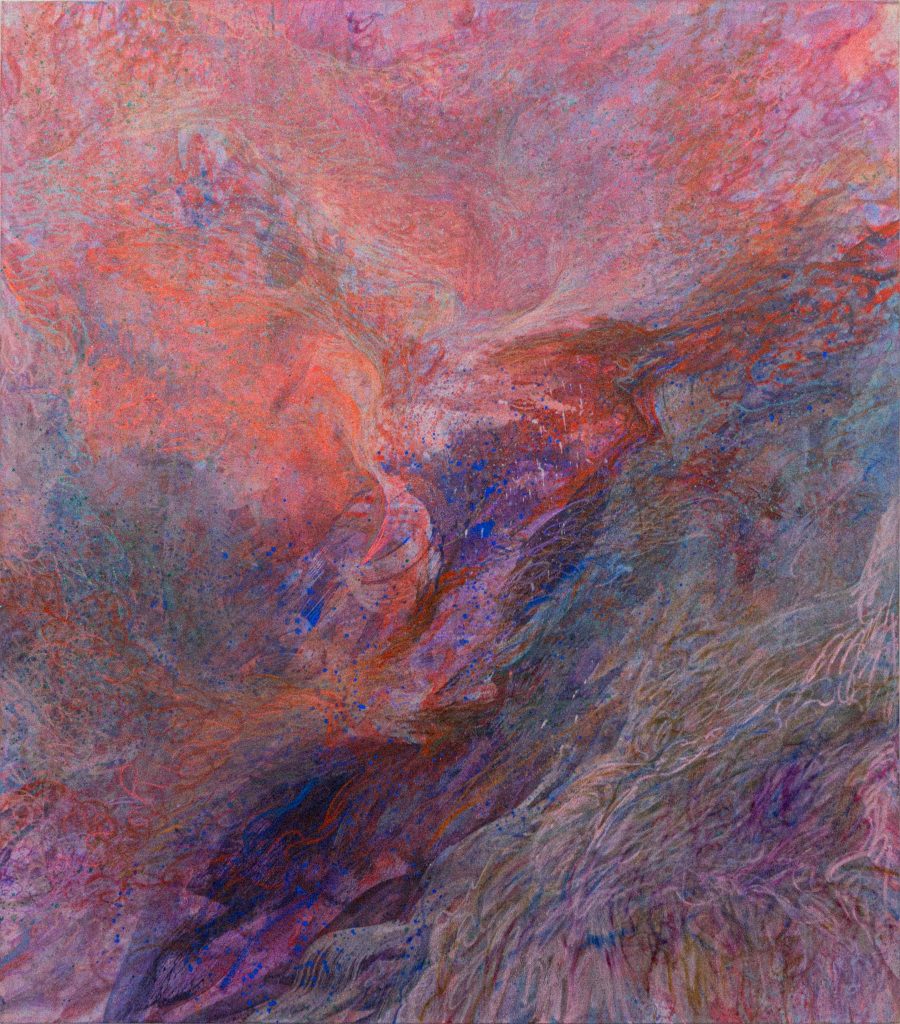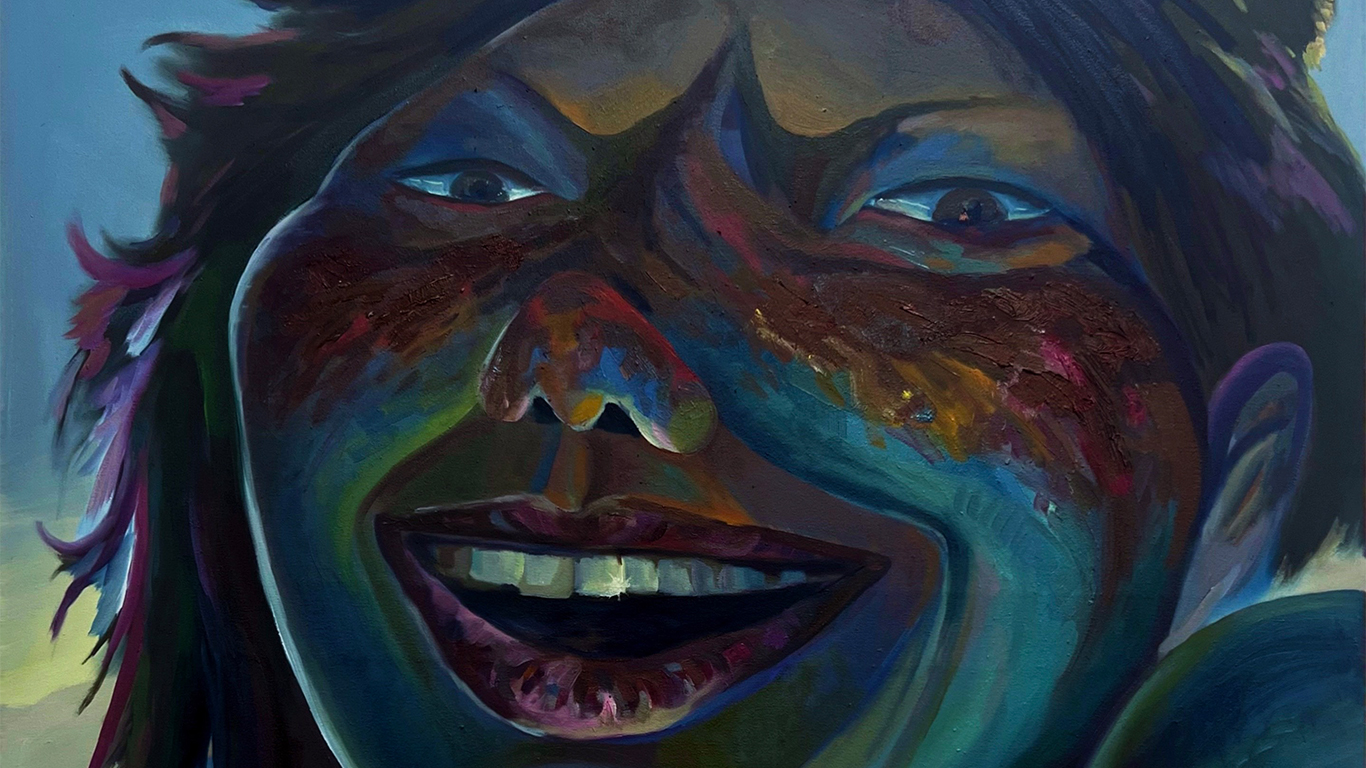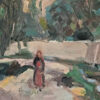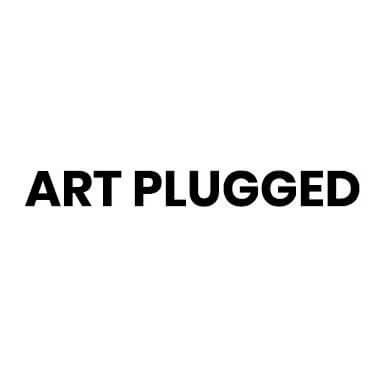MAKING KIN
14th MARCH, 2024 – 11th APRIL, 2024
STUDIO WEST
216 KENSINGTON PARK ROAD
LONDON
W11 1NR
MAKING KIN, a group exhibition featuring predominantly new paintings by five female artists: Imogen Allen, Olha Pryymak, Yuma Radné, Paula Turmina and Freya Fang Wang, alongside photographic prints and research materials by Plantaphilia (a collaboration between PhD student Iria Suárez Martínez and artist Paula Turmina). Inspired by multispecies feminist theorist Donna Haraway’s book, ‘Staying with the Trouble: Making Kin in the Chthulucene’ (2016), the exhibition brings together practices which utilise storytelling to explore ways of reimagining humanity’s relationship with the earth and its inhabitants.

Taking up Haraway’s invitation to “stay with the trouble” by “making oddkin”, these artists draw on their experiences of post-colonial, indigenous, herbalist and rural contexts to envisage alternative ways of living together on a damaged earth. From hopeful narratives of symbiotic flourishing, to visions of post-apocalyptic survival, the works on show invite viewers to recognise the power of speculative-fiction in carving out routes to alternative futures besides global ecological devastation.
In Freya Fang Wang’s work, rhetorical devices central to Donna Haraway’s theoretical framework are made manifest. Haraway interchangeably deploys the moniker ‘SF’ to refer to “science fiction, speculative fabulation…speculative feminism, science fact”, and crucially “string figures”, a tentacular model of thinking, inspired by the children’s game Cat’s Cradle, that underlines the interconnectedness of all things. Wang’s fluid, abstract and enveloping canvases can be understood as string-figure models; visualisations of entire universes where all things are intertwined in unbreakable and endless webs.
Deeply rooted in Chinese philosophy and culture, Wang’s current practice can be traced back to a transformative moment when she felt the oneness with nature that Taoism describes while standing upon a cliff in the south of England. Inspired by this personal epiphany, her works seek to celebrate mutually beneficial entanglements between life forms, while excavating the spiritual power of the natural world.

Oil Pastel, Plaster, Salt, Pigment on Canvas, 165 x 145 x 4cm.
Image Courtesy of the Artist and STUDIO WEST
Despite appearing similarly abstract, Imogen Allen’s paintings are ever-shifting and enticing explorations of a very particular life form – Lichen. Formed of algae and fungi, Lichen is one of very few composite organisms to exist on our planet and a crucial bio-indicator that flourishes in clean air conditions, while absorbing and metabolising pollutants such as carbon. Surviving over thousands of years, its endurance can be attributed to its collaborative nature, providing a model for “making kin” with other beings as a route to earthly survival.
Allen’s studio is on the edge of the West Penwith Moorlands in Cornwall, an area where lichen blankets stones, grasses and the branches of withered trees to form inherently sculptural and undefinable forms that the artist finds continuously inspiring. Motivated by a personal passion for these unique organisms, Allen’s practice fuses a scientific understanding of Lichen’s vital role in the earth’s ecosystem with a delicate painterly sensibility to draw viewer’s attention to these oft-overlooked, yet essential, co-habitants of our plant.
Informed by the native herbalist practices of her birth country Ukraine, Olha Pryymak also explores plant-human relationships through surreal, still life paintings. She manifests a nurturing, mystical and holistic approach to horticulture in her work, inspired by knowledge systems that have historically been undermined by forces of colonialism, capitalism and globalisation.
In so doing, she aligns herself with Haraway’s argument that a solution to the “trouble” of the present is unlikely to be found in anthropocentric promises of technological advancement, and instead evokes alternate past and present ways of living with nature to offer lessons for the future. By positioning plants as the protagonist in her works, meanwhile, she rejects a human centric world-view thereby taking up Haraway’s notion that, “It matters what matters we use to think other matters with; it matters what stories we tell to tell other stories with”.

Mars Pigments and Oil on Calico, 28 x 33cm (framed).
Image Courtesy of the Artist and STUDIO WEST
A collaborative research project between PhD student Iria Suárez Martínez and artist Paula Turmina, Plantaphilia also positions plants as storytellers. Through analog filmmaking, a method they liken to photosynthesis due to both processes’ reliance on light, Martínez and Turmina have documented the plants that line London’s Regent’s Canal. Predicated on “making kin” and “making with” the other-than-human, they understand their work as a collaboration with the plants they study – it involves an attempt to understand and embody the way that plants might think or feel.
Fusing artistic and scientific approaches, as Haraway does, they have traced the migration of London-dwelling vegetation to locations all over the world. Focussing on species considered invasive or environmentally detrimental, the duo compared the similarities in the use of xenophobic language to otherize both migrant plants and people. In so doing, they exposed the “bounded individualism”, or lack of collectivity, that Haraway argues is “unavailable to think with” if both humanity and our planet are going to survive.
This notion of survival is central to Paula Turmina’s practice. Inspired by science-fiction narratives, her paintings offer an unsettling vision of our planetary future: a much warmer world populated by post-apocalyptic survivors who find solace in venerating the sun, despite becoming burned or blinded by its rays. Appearing almost like mirages, her use of warped perspectives and beaming orange pigments imbues her pieces with an atmosphere of intense heat. Both charming and shocking, they quietly threaten the viewer by visualising the reality humanity is liable to create.
Faced with the impact of colonial histories on ecological development and a perceived inadequacy among politicians to address global warming, Turmina’s work can be understood as an act of “speculative-fabulation” – a fusion of fact and fiction utilised, in this case, to deliver a salient message. Comparable with Haraway’s “Camille Stories”, in which she imagines five future generations of animal-human hybrids as a way to materialise unreserved interspecies kinskip, Turmina’s paintings offer an alternative vision of “staying with the trouble” in which new relationships form between the inhabitants of a forever-changed world.

Image Courtesy of the Artist and STUDIO WEST
Built upon her heritage as a descendant of the Buryats, a Mongolian Indigenous group, Yuma Radné’s work is equally predicated upon myth-making. Similarly comparable with Haraway’s Camille Stories, in which the characters are fusions of human children and Monarch butterflies, Radné’s work presents the viewer with compellingly novel embodiments; mermaids frolic upon sentient rocks, while naked figures ride upon benevolent sea-creatures. Often taking inspiration from the ancient traditions, rituals, and beliefs of her people, Radné’s figures demonstrate the multispecies kinship that surrounded the artist as a child. Energetic, bright and jubilant, her canvases position all beings as mischievous co-actors in playful and humorous narratives, thereby turning the viewer’s attention to their own understanding of their place within a multispecies universe.
Following Donna Haraway’s argument in “Staying with the Trouble”, ‘MAKING KIN’ does not attempt to propose a solution to the “troubling and turbid” nature of our times. Instead, through the work of artists whose practices make kin with the other-than-human or tell stories of alternative futures with tools from their pasts, the exhibition creates a space for imagining. A realm in which to engender artworks with the power to answer Haraway’s salient question: “What must be cut and what must be tied if multispecies flourishing on earth, including human and other-than-human beings in kinship, are to have a chance?”.
MAKING KIN opens on the 14th of March, 2024 until the 11th of April, 2024 at STUDIO WEST
©2024 Studio West





